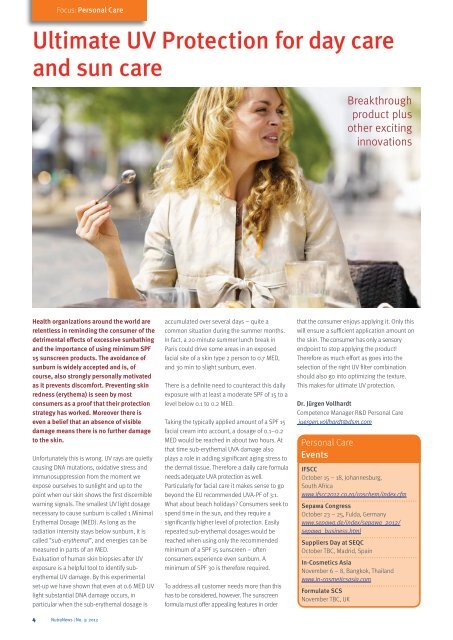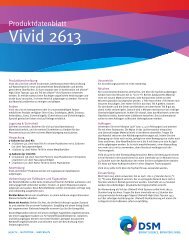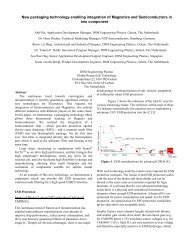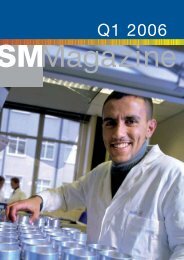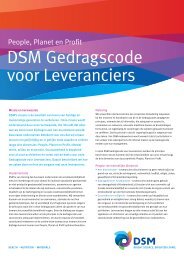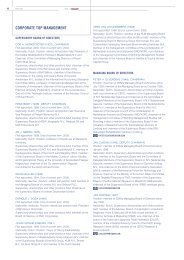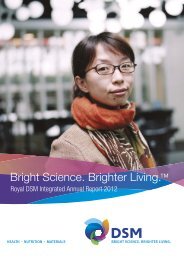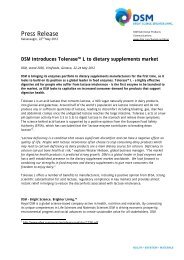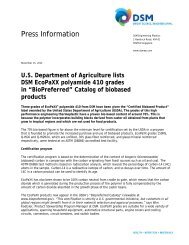NutraNews - DSM Nutritional Products newsletter 3/2012
NutraNews - DSM Nutritional Products newsletter 3/2012
NutraNews - DSM Nutritional Products newsletter 3/2012
You also want an ePaper? Increase the reach of your titles
YUMPU automatically turns print PDFs into web optimized ePapers that Google loves.
Ultimate UV Protection for day care<br />
and sun care<br />
Health organizations around the world are<br />
relentless in reminding the consumer of the<br />
detrimental effects of excessive sunbathing<br />
and the importance of using minimum SPF<br />
15 sunscreen products. The avoidance of<br />
sunburn is widely accepted and is, of<br />
course, also strongly personally motivated<br />
as it prevents discomfort. Preventing skin<br />
redness (erythema) is seen by most<br />
consumers as a proof that their protection<br />
strategy has worked. Moreover there is<br />
even a belief that an absence of visible<br />
damage means there is no further damage<br />
to the skin.<br />
Unfortunately this is wrong. UV rays are quietly<br />
causing DNA mutations, oxidative stress and<br />
immunosuppression from the moment we<br />
expose ourselves to sunlight and up to the<br />
point when our skin shows the first discernible<br />
warning signals. The smallest UV light dosage<br />
necessary to cause sunburn is called 1 Minimal<br />
Erythemal Dosage (MED). As long as the<br />
radiation intensity stays below sunburn, it is<br />
called “sub-erythemal”, and energies can be<br />
measured in parts of an MED.<br />
Evaluation of human skin biopsies after UV<br />
exposure is a helpful tool to identify suberythemal<br />
UV damage. By this experimental<br />
set-up we have shown that even at 0.6 MED UV<br />
light substantial DNA damage occurs, in<br />
particular when the sub-erythemal dosage is<br />
4<br />
Focus: Personal Care<br />
<strong>NutraNews</strong> | No. 3: <strong>2012</strong><br />
accumulated over several days – quite a<br />
common situation during the summer months.<br />
In fact, a 20-minute summer lunch break in<br />
Paris could drive some areas in an exposed<br />
facial site of a skin type 2 person to 0.7 MED,<br />
and 30 min to slight sunburn, even.<br />
There is a definite need to counteract this daily<br />
exposure with at least a moderate SPF of 15 to a<br />
level below 0.1 to 0.2 MED.<br />
Taking the typically applied amount of a SPF 15<br />
facial cream into account, a dosage of 0.1–0.2<br />
MED would be reached in about two hours. At<br />
that time sub-erythemal UVA damage also<br />
plays a role in adding significant aging stress to<br />
the dermal tissue. Therefore a daily care formula<br />
needs adequate UVA protection as well.<br />
Particularly for facial care it makes sense to go<br />
beyond the EU recommended UVA-PF of 3:1.<br />
What about beach holidays? Consumers seek to<br />
spend time in the sun, and they require a<br />
significantly higher level of protection. Easily<br />
repeated sub-erythemal dosages would be<br />
reached when using only the recommended<br />
minimum of a SPF 15 sunscreen – often<br />
consumers experience even sunburn. A<br />
minimum of SPF 30 is therefore required.<br />
To address all customer needs more than this<br />
has to be considered, however. The sunscreen<br />
formula must offer appealing features in order<br />
Breakthrough<br />
product plus<br />
other exciting<br />
innovations<br />
that the consumer enjoys applying it. Only this<br />
will ensure a sufficient application amount on<br />
the skin. The consumer has only a sensory<br />
endpoint to stop applying the product!<br />
Therefore as much effort as goes into the<br />
selection of the right UV filter combination<br />
should also go into optimizing the texture.<br />
This makes for ultimate UV protection.<br />
Dr. Jürgen Vollhardt<br />
Competence Manager R&D Personal Care<br />
juergen.vollhardt@dsm.com<br />
Personal Care<br />
Events<br />
IFSCC<br />
October 15 – 18, Johannesburg,<br />
South Africa<br />
www.ifscc<strong>2012</strong>.co.za/coschem/index.cfm<br />
Sepawa Congress<br />
October 23 – 25, Fulda, Germany<br />
www.sepawa.de/index/sepawa_<strong>2012</strong>/<br />
sepawa_business.html<br />
Suppliers Day at SEQC<br />
October TBC, Madrid, Spain<br />
In-Cosmetics Asia<br />
November 6 – 8, Bangkok, Thailand<br />
www.in-cosmeticsasia.com<br />
Formulate SCS<br />
November TBC, UK


